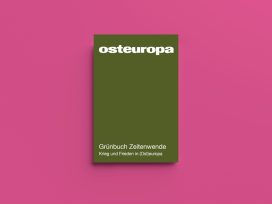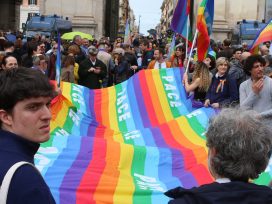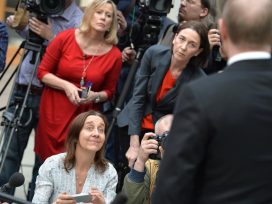Charlie Hebdo's Russian afterlife
Russian responses to the Charlie Hebdo attack in Paris reveal the contradictions of political and social trends in today’s Russia, writes Nikolay Mitrokhin; with the most dramatic response being the unprecedented political killing of leading opposition politician Boris Nemtsov.
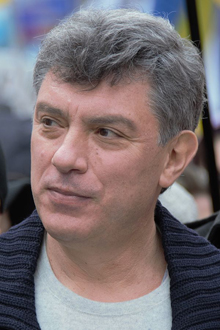
Boris Nemtsov was assassinated on 27 February 2015; he is pictured here in March 2014. Photo: Dharmikatva. Source:Wikimedia
The shooting of the editors of Charlie Hebdo magazine in Paris, a major terrorist act, and the equally major response to the crime among the European Union public, provoked quite a different reaction in Russia. Its most striking manifestation was not individual vigils by radical Orthodox believers outside the French Embassy expressing support for Islamist terrorists, nor mass rallies in Grozny, the capital of Chechnya, condemning the slain journalists, but the unprecedented political killing of leading opposition politician Boris Nemtsov. It happened in an open space some hundred metres from the Kremlin, the well-guarded residence of the country’s President. The motive for the killing, according to the investigators’ official version, was revenge for the politician’s show of solidarity with the journal’s editors, which had allegedly offended a leader of the pro-Russian paramilitary structures in Chechnya.
The tragedy of the killing notwithstanding, it would be a simplification to describe the society of present-day Russia as an environment dominated by supporters of religious fundamentalism and terrorism, who are opposed to freedom of speech. Nevertheless, both the discussion triggered by the terrorist attack against Charlie Hebdo and the response to it illustrate the range of social and ideological issues which are of concern to Russians today.
Russia lives in a different social time
Some Russian social thinkers (with whom this author agrees) share the belief that in terms of social development Russian society lags several decades behind the dominant trends typical of the core of the EU and other countries of the West. Incidentally, this applies not just to Russia but also other countries that are in the orbit, albeit on the relative periphery of, the western world: Ukraine, Romania, Turkey, Mexico and some others. In these countries the process of urbanization, industrialization and increased access to secondary education occurred with a considerable delay compared to the West. As a result, fundamental social transformations and the corresponding social practice, discussion and discourse, have been significantly delayed, to the amazement of those who live in a different social time – namely, western observers, who are primarily familiar with life in these countries from television.
The Russian “social clock” is thus currently somewhere in the first half of the 1970s, in terms of “European time”, with the “political clock” corresponding to the mid-1950s. While the country’s political life is increasingly dominated by right-wing conservatives who have a penchant for militarism, nothing but contempt for human rights and links to the criminal underworld, the last ten years have seen a blossoming of hipsters in major cities – young people championing various social and cultural initiatives. In the past five years, as public debate has focused on the situation of disabled people and the difficulties faced by wheelchair users in Russian cities, local councils have started installing ramps and lifts in underpasses and exploring the options of promoting cycling and reorganising urban spaces to make them more user-friendly. A number of voluntary groups have sprung up that collect funds for a plethora of social initiatives supporting various kinds of have-nots – something that had not been of interest to anyone in previous decades. The Russian Orthodox Church (ROC), particularly in large urban youth communities, has undergone the most intensive, albeit unadvertised, reforms. There has been growing interest in the problems of minorities (especially LGBTI) and migrants.
Migrants represent a significant problem in major Russian cities. The rapid decrease in migration from Russia’s villages into the cities that took place as a result of urbanization, as well as Russia’s economic growth in the 2000s and the early 2010s, has inevitably caused a radical increase in migration from other countries, mostly in the Caucasus and Central Asia. This process closely resembles developments in major countries such as West Germany and France in the 1960s and 1970s. Many cities attracted growing numbers of people who stood out not only due to their poor knowledge of the host country’s language but also externally, because of different customs, behaviour and religion. And while some sections of the population were happy to accept them and help them adapt, others were wary and were keen to get rid of them. Ironically, it was also the 1970s that saw the bourgeoning of home-grown terrorist groupings (both on the Left and on the Right) as well as of mafia structures fostered by the countries’ “indigenous” inhabitants, who resorted to violence more readily than migrants concerned about their day-to-day survival.
Present-day Russia is going through an analogous development. The authorities and demographers estimate the number of migrants without Russian citizenship at between 10 and 15 million. Although Russian special services periodically arrest Islamic radicals from Central Asia who came to Russia to seek safe haven (until recently, they were able to enter the country without a visa and even without a passport), they are not known to have engaged in any terrorist activities on Russian territory. On the other hand, they have been the target of racist attacks (with as many as a hundred dead per year) or assaults by mafiosi structures of various kinds.
At the same time, it seemed as if hundreds of thousands of migrants suddenly emerged in major and medium-sized cities (with migration from Central Asia reaching its peak roughly between 2002 and 2010). This raised concerns among the population, even among otherwise liberal-minded people. The fear of the country’s “Islamization” is stoked by the massive turnout of migrants for the annual Eid holiday that marks the end of Ramadan. On this day streets and squares within hundreds of metres of the rather limited number of legal mosques (Moscow, with its 15 million inhabitants, boasts less than ten) are covered in prayer mats which tens of thousands of people bring out to perform Namaz.
Reaction to the murder
That is why a large section of Russia’s intellectual community perceived the Charlie Hebdo shooting not just as a major tragedy but also as confirmation of their old fears: clearly, Muslim migrants must be a source of danger to everyone who shares genuine European values. Another frequently cited argument is that of the Israeli-Palestinian conflict, which many Russian intellectuals know from personal experience since many of their friends and relatives live there.
For example, in a comprehensive essay on the opposition website Otkrytaya Rossiya (“Open Russia”), Lyudmila Ulitskaya, one of the most acclaimed Russian writers and a prominent member of the anti-Putin opposition, wrote of an “Islamist terrorism” threat. She argued that the root of the tragedy was Europe’s “total lack of understanding of the threat Islamic State poses to present-day civilization”. She went on to endorse Israel’s policy of destroying terrorists’ homes and an analogous practice applied in Chechnya on Ruslan Kadyrov’s orders.
Another type of response has been equally widespread. Literally within a couple of days of the attack on the Charlie Hebdo journalists, Russian social media were flooded with a selection of the journal’s covers on religious subjects. The cartoon depiction of sacred figures reminded members of the Russian intelligentsia of the most offensive anti-religious posters of the 1920s, which had paved the way for mass closures of churches and the persecution of religious believers. Furthermore, some of the cartoons also had sexual content. Many Russians, including those who are pro-western, do not associate this type of cartoon with “freedom of the press”, which they understand as a chance to discuss lofty ideals (political freedoms, human rights, the right to worship) rather than “obscenities”.
The renowned architectural critic Grigory Revzin pointed out this contradiction in a Facebook status that generated dozens of comments. After stating that he had laid flowers at the French Embassy he said that these cartoons had little to do with “freedom of expression” but rather were a part of a specific European “laughter culture”, which had more in common with the medieval carnival than with present-day notions of tolerance. He went on to say that the killers acted in accordance with their equally medieval ideas of reacting to what they regard as offensive. His column, parts of which were reprinted in the popular progressive Orthodox journal Pravoslavie i mir (“The Orthodox Church and the world), concludes as follows: “Our fundamentalists – whether they are represented by the Russian Orthodox Church, the state, the Kazakhs or His Chechen Majesty – hate liberalism sufficiently for those things that are at its core: respect for the individual, equality before the law, fundamental freedoms, the idea of changing power democratically. So why should we give them an opportunity to declare that all liberalism is smut and blasphemy? What makes Putin terrible is not that he imprisoned the Pussy Riot girls; he can call upon many other achievements. But he turned himself into a laughing stock by imprisoning them.” Three days after the column appeared Revzin was attacked outside his house by a stranger with a knuckle-duster and badly beaten up. While he himself put this down to a possible “common criminal incident”, it no longer appears as one in the wake of Nemtsov’s murder.
However, the cartoons have provoked a much stronger reaction in many Russians who are religious believers or sympathizers, or are simply conservative-minded. Opinions ranged from a position similar to Revzin’s, i.e. “provoking extremists was a bad idea”, to “the cartoonists only have themselves to blame”. Initially the proponents of these views only aired their outrage against the memorialising of the slain cartoonists on social media. While several hundred people laid flowers outside the French Embassy there were a few individuals who held vigils in support of the terrorists. However, these representatives of an extremely small radical Orthodox group are rather savvy in the art of street propaganda. And their calculation paid off – the five individuals who held banners declaring their support for the terrorists were featured by all major global media, while journalists did not seem to notice the hundreds who paid tribute to the victims.
Reaction to “Je suis Charlie”
The events surrounding the Paris killings acquired a whole new dimension when the Russians realized the scale of the global campaign for freedom of expression under the “Je suis Charlie” slogan. Instead of being drowned by the spate of information, the killings continued to animate the public for at least another two weeks. The most impressive event was the 13 March multimillion march of unity in Paris, attended by top European and world leaders.
Supporters of religious and conservative values were rather puzzled by this kind of solidarity since it went against the grain of the current Russian trend of fighting those who “offend the feelings of religious believers”. Ever since Orthodox fundamentalists stormed the 2005 exhibition Ostorozhno – religiya! (“Beware, religion!”), and its organizers were convicted of “publicly expressing a derogatory attitude to the Christian religion in general and the Russian Orthodox Church in particular”, the judiciary has shown a strong tendency to persecute artists who experiment radically with religious symbols. The Pussy Riot case of 2012 fits into this pattern. On the other hand, religious extremists have been subjected to equally fierce persecution by the state, with bans on religious literature that promotes violence or simply the idea of the “supremacy of one religion above another”. While in present-day Russia these policies are not as comprehensive as under the Soviet totalitarian era, the authorities have made a visible attempt to achieve a forcible – i.e. court-imposed – reconciliation between the most avant-garde (and anti-religious) parts of society on the one hand and religious activists on the other. On 30 June 2013, in response to the Pussy Riot performance in Moscow’s Cathedral of Christ the Saviour, the State Duma passed a law against offending the feelings of believers, which envisages hefty fines and up to three years’ imprisonment for individuals found guilty of participating in “public actions that show obvious lack of respect for society with the aim of offending the religious feelings of believers”.
Since the hero-worshipping of Charlie Hebdo cartoonists clearly upset the “balance of power” in favour of liberal critics of religion, it has provoked a variety of responses. Initially, the most typical among them were so-called demotivators (satirical graphics) and “Je ne suis pas Charlie” slogans.
For example, Stanislav Kulov – a lawyer with the Slavic Legal Centre, a Protestant legal organization in Moscow and well-known advocate of the rights of Christian believers suffering discrimination from regional authorities and the ROC – posted on his blog: “It’s really hard to defend a journal that publishes such disgusting, vulgar cartoons, sometimes of an openly blasphemous character. I think people should first think of the consequences before they draw something sensational purely for self-promotional purposes. Yes, satire is meant to be cutting but it’s not meant to be offensive. Evil breeds evil, as subsequent explosions in a Paris mosque have shown. Some might object that it’s just a picture… but it’s not just a picture! In my view, this borders on extremism. And the state should have reacted to these attacks… I am not Charlie because I respect those around me. I don’t want to turn these people into heroes, and I don’t want my heroes to resemble these people at all.”
However, soon after these private comments on the Internet, government-organized forces joined the offensive. On 15 January the state censorship agency Roskomnadzor officially banned Russian media from reproducing cartoons from the journal.
Russia’s social media propaganda machine was also actively involved in the reinterpretation of the “Je suis Charlie” meme. On 13 January, after Russian fighters shelled a bus in the village of Volnovakha, then under the control of the Ukrainian army, causing 12 civilian deaths, Ukrainian president Petro Poroshenko coined the slogan “Je suis Volnovakha”, which became quite popular in Ukraine. In response Russian social media trolls (it is well known that a “troll factory” operates in St Petersburg) started supplying Putin’s followers and a group that supports Russian aggression in Ukraine with demotivators and other graphic designs that subverted the “Je suis…” slogan, using it in the exactly opposite way. The journal’s name was replaced by other content symbolising the victims of the conflict, such as the names of civilians or place names. The most popular demotivator was “Je suis Vanya”. It showed the photo of a little boy, allegedly killed in the Donetsk Region by Ukrainian army shelling. Against the backdrop of military activities that flared up in mid-January these slogans and demotivators were frequently used in social media.
Kadyrov: Nemtsov and other potential victims
However, quite unexpectedly, the person who became most seriously entangled in the Charlie Hebdo affair was the Chechen leader Ramzan Kadyrov. This young dictator and member of “Team Putin” is the son of former Chief Mufti of Chechnya, Akhmat Kadyrov. In the first Chechen War, from 1994 to 1996, his family fought on the side of Chechen separatists but early in the second Chechen War they switched sides, joining the federal authorities. The reason for the change of allegiance was the fact that during the brief existence of an independent Chechen state from 1996 to 1999 real power came into the hands of radical Salafists. They opposed the Sufi branch of Islam, whose leaders included Kadyrov senior. In the wake of the Russian army’s victory, Akhmat Kadyrov became leader of the region. When he was assassinated in 2004 his very young son (28 at the time) inherited his position and power and since then, aided by former separatist fighters, has terrorized the region’s population using brutal force.
Praising Putin to heaven in his speeches, Kadyrov has benefited from extensive financial support for rebuilding Chechnya and strengthening his dictatorial regime. He has established a semi-religious social system, which involves not only the building of huge mosques (and sports stadiums), the teaching of Islam in secondary schools (there is nothing comparable in other parts of Russia), but has also exercised semi-official control over the way Chechen women dress, imposing an unofficial ban on women smoking in public and other traditionalist and neo-traditionalist restrictions. To compensate for his active struggle with the Salafist underground Kadyrov has cultivated intensive contacts with the Islamic Ummah, including the Salafist Gulf governments.
In effect, Kadyrov lays claim to the role of a leader of the Islamic Ummah or, at the very least, leader of Russia’s Muslims, even though he lacks a solid theological education. That is why he is trying to win authority by presenting himself as an Islamist statesman and energetic defender of the faith. And this explains in turn his rather overwrought reaction to the memorialising of the dead cartoonists. When opposition politician Mikhail Khodorkovsky called for the publication of the cartoons in Russia and Aleksei Venediktov, editor-in-chief of the progressive radio station Ekho Moskvy publicly wondered whether he should publish them on his station’s website, Kadyrov declared them his personal enemies and claimed that there are some people who might avenge this insult to Islam. Incidentally, Kadyrov has made similar claims on several previous occasions, but these were always forgotten after a few days of media frenzy.
This time Kadyrov went to extraordinary lengths to present himself as a defender of Islam. On 19 January he organized a major rally in the Chechen capital Grozny, intended as a show of outrage on the part of the entire Muslim population of the north Caucasus. Three of the territory’s regions – Chechnya, Ingushetia and Dagestan – are indeed profoundly Islamicized. Nevertheless, Kadyrov’s flagship event, for which the population of the republic was given a day off work, was a visibly artificial affair. The town’s inhabitants turned up at the rally with identical printed banners and identical balloons inscribed with words of love for the Prophet. Despite the declared intention to assemble a million people, the true number of participants was many times smaller and consisted primarily of those in the region dependent on Kadyrov’s dictatorship.
The media recalled Kadyrov’s threats right after Boris Nemtsov’s murder on 28 February, which happened in close proximity to the Kremlin, inside Putin’s personal security zone. That is why, unlike previous notorious political killings in Russia in the past two decades, the actual perpetrators were caught in a matter of days. According to the investigators, Boris Nemtsov had been shot by Zaur Dadayev, deputy commander of the Russian army’s “Sever” regiment, which is de facto under the command of Ramzan Kadyrov. This regiment consists of former Chechen Islamist separatists who had succumbed to Chechnya’s new authorities and are personally loyal to Ramzan Kadyrov. Dadayev was assisted by several members of the Chechen and Ingush diaspora in Moscow.
According to Dadayev’s officially reported initial statements his motive for the murder was that he felt offended by Boris Nemtsov’s statement on social media (as in Grigory Revzin’s case) that Islamists are medieval obscurantists. After this was reported by the media, Kadyrov said in an official statement that Dadayev was an excellent fighter, a loyal Russian patriot, and a deeply religious man, and that he understood the motives for his actions. However, it later turned out that Dadayev was paid a large sum of money – five million Russian roubles (over 80,000 euros) – for planning the murder.
Although many aspects of the killing remain unclear, and the individuals who had passed on the money to the perpetrators and organized Dadayev’s meetings with his helpers are yet to be apprehended, the trail obviously points to the Chechen leadership. Kadyrov has often been publicly accused of ordering killings of his political opponents, human rights activists and journalists both in Russia and abroad. Nevertheless, the few people who have ended up behind bars, have been the actual perpetrators, such as Anna Politkovskaya’s killers, and have kept stubbornly quiet about who had ordered the crimes.
Nemtsov was not the most prominent champion of Charlie Hebdo in Russia, which is why it has been suggested that the possible real motive for the killing was his long-standing conflict with the Kadyrov family. The family features in his political memoirs, from which a quote has been doing the rounds on social media since his killing. In 2001, after Nemtsov criticized Kadyrov at a major meeting in Chechnya for starting to monopolize power, he met a young man wearing the uniform of a colonel in the Russian army, who told him straight out that he deserved to be killed for speeches like these. That colonel was Ramzan Kadyrov himself.
Since Kadyrov’s threats have suddenly turned rather real, the Russian media have reported the existence of a “hit list” of his enemies. It includes all those he had publicly threatened in the Charlie Hebdo context: Khodorkovsky, Venediktov, as well as Kadyrov’s former friend, the TV presenter Ksenia Sobchak (daughter of Putin’s former mentor and protector, the late governor of St Petersburg Anatoli Sobchak), who in the late 2000s morphed from a celebrity into a leading opposition and pro-democracy activist.
Summing up the story of the Charlie Hebdo journalists’ afterlife in Russia, it has become a litmus test, exposing the contradictions of political and social trends in present-day Russia. Moreover, it has underlined a profound conflict between the out-dated political regime in the country, stuck in the McCarthy era and partly relying on governors whose dictatorial rule is reminiscent of the 1950s-1970s Latin American banana republics on the one hand, and, on the other, urban communities that inhabit a completely different social time. The latter still hope for and work to effect change, and the authorities are trying to hinder them in every conceivable way, including by killing those who hold opposing views.
Published 10 April 2015
Original in English
Translated by
Julia Sherwood
First published by Eurozine
Contributed by Transit © Nikolay Mitrokhin / Eurozine
PDF/PRINTNewsletter
Subscribe to know what’s worth thinking about.
Related Articles

Russian art museums and galleries, navigating Putin’s censorship, either conform or risk closure. Dissenting cultural workers are sacked, artists arrested. Pro-war propaganda is both sardonically replacing exhibitions once celebrating Soviet Ukraine in Russia and eradicating Ukrainian culture in the occupied territories.
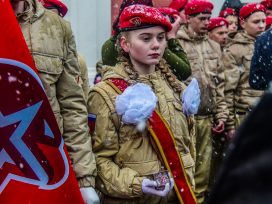
Intellectual violence
The militarization of education in Russia
Education has become another battleground in the Kremlin’s campaign to militarize the Russian public consciousness. Youth organizations, book bans, changes to school curricula – all amount to a ‘special anthropological operation’.



